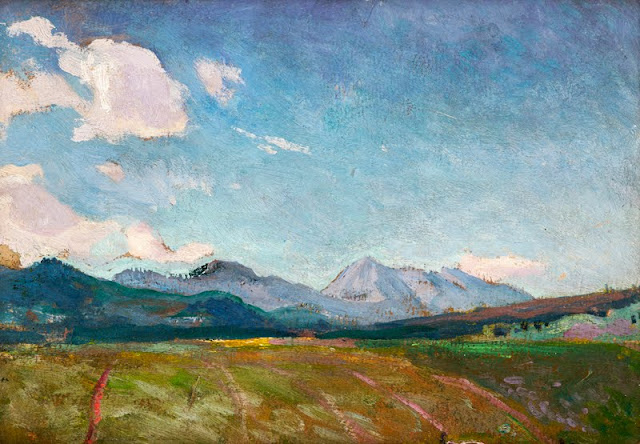ASCAN LUTTEROTH (1842-1923)
Monte Solaro (589m - 1,932ft)
Italy (Campania)
In Capri and Monte Solaro from a boat, 1923, oil on canvas
In Capri and Monte Solaro from Punta Campanella, 1922, oil on canvas
The mountain
Monte Solaro (589m - 1,932ft) also called Monte Solare or Monte Solara is the highest point of the island of Capri in Campania, in the Gulf of Naples, Italy. Monte Solaro is formed from the same limestone that the island is composed of. Monte Solaro has a typical mediterranean climate, but with colder winters because of the high altitude. From the top of Monte Visto, one can see both the gulfs of Napoli and Salerno.
The summit is accessible by walking without too much difficulty by either the passetiello or a path that starts from Axel Munthe. Both routes are suitable for walkers in decent physical condition. Notable sites include the Eremo di Santa Maria a Cetrella for its architecture, and the remains of the Fortino di Bruto, a military fort built during the Napoleonic Wars.
Mount Solaro contains the "Fortino di Bruto", a blockhouse which was used in battles between Britain and France in the early 19th century. It is characterised by its "sheer dolomitic slopes" which form an "unsurpassable partition" between the eastern and western sides of the island.
Marina Grande lies at the foot of the mountain. It became popular with painters due to its "romantic situation, affording extensive and beautiful views to the NW of the Tyrrhenian sea, the gulf of Naples". Up the mount there is a statue of Emperor Augustus who first landed on Capri.
The area around Monte Solaro is inhabited by over 900 species of vegetation. The mountain is also visited by many species of birds, including peregrine falcons.
The Painter
Ascan Lutteroth was a German landscape painter, son of the banker Christian Alexander Ascan Lutteroth. He studied from 1861 with Alexandre Calame in Geneva and 1864 to 1867 with Oswald Achenbach in Düsseldorf. From 1868 to 1870 he lived in Italy, he went and live in Capri for a while, before going to Berlin until 1877. Crown Prince Frederick William and Crown Princess Victoria greatly appreciated him. In 1879 they took him on their journey to San Remo and Lutteroth became the teacher of the Crown Princess. In 1890 Wilhelm II gave him the official title of professor. He is regarded as the most important Hamburg landscape painter of his time. Until 1909 he was chairman of the Hamburg artist 's workshop of 1832. Among the 91 paintings and 32 watercolors he produced, Lutteroth mainly painted landscapes from Italy and the Hamburg area, alpine and forest scenes, sparingly populated with small figures. His works were represented in the major national and international exhibitions, including in the Berlin National Gallery, the Rudolfinum Prague, and the Magdeburg Gallery. Today the Hamburger Kunsthalle, the Anhaltische Gemäldegalerie Dessau in the Georgian Palace, the Museumberg Flensburg, the Städtische Galerie Rosenheim and the Museum Villingen-Schwenningen have pictures by him. In the Leipzig Museum, there was a painting of the Mawensi (East Summit of Kilimanjaro) depicting Lutteroth in 1889, with the African farmer and researcher Hans Meyer. Donated to the Museum Leipzig Museum in 1890 by J. Meyer, this work has been lost since the Second World War.
































